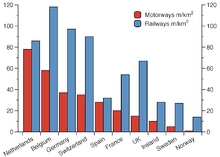Transport in the European Union


Transport in the European Union is a shared competence of the Union and its member states. The European Commission includes a Commissioner for Transport, currently Violeta Bulc. Since 2012, the Commission also includes a Directorate-General for Mobility and Transport which develops EU policies in the transport sector and manages funding for Trans-European Networks and technological development and innovation, worth €850 million yearly for the period 2000–2006.
Air transport
The European Aviation Safety Agency has regulatory and executive tasks in the field of civilian aviation safety, such as issuing type certificates.
The Commission has also taken the initiative for a Single European Sky to co-ordinate the design, management and regulation of airspace in the Union.
The EU also participates in Eurocontrol, which coordinates and plans air traffic control for all of Europe.
Water transport
The European Maritime Safety Agency (EMSA) is charged with reducing the risk of maritime accidents, marine pollution from ships and the loss of human lives at sea by helping to enforce the pertinent EU legislation.
Railway transport
The European Railway Agency has the mandate to create a competitive European railway area, by increasing cross-border compatibility of national systems, and in parallel ensuring the required level of safety. The ERA sets standards for European railways in the form of ERA Technical Specifications for Interoperability, which apply to the Trans-European Rail network.
The first EU directive for railways requires allowing open access operations on railway lines by companies other than those that own the rail infrastructure. It does not require privatisation, but does require the separation of infrastructure management and operations. The directive has led to reorganisations of many national railway systems.
The EU has also taken the initiative of creating the European Rail Traffic Management System (ERTMS), a single standard for train control and command systems, to enhance cross-border interoperability and the procurement of signalling equipment.
Road transport
Germany, Spain and France possess the most extensive network of motorways exceeding 10,000 km each. This figure is more than double to any other European country. Similarly, their rail infrastructure surpasses 15,000 km.[1] The total investment reached 6,000 millions for Spain and nearly double of this for Germany and France.[1] In terms of their population and territorial extension the Netherlands and Belgium have a better coverage and higher investment per square kilometer.[1]

According to Union guidelines for the development of the trans-European transport network [2], "high-quality roads shall be specially designed and built for motor traffic, and shall be either motorways, express roads or conventional strategic roads."
Motorways and Express road
For some topics, law applicable for roads is based on European directives and some international treaties such as European Agreement on Main International Traffic Arteries of 15 November 1975.
In European Union, a road can be considered as a "motorway" or also as an "express road".
In European union, the notion of express road is slightly less strict than the notion of motorway; according to the definition, "an express road is a road designed for motor traffic, which is accessible primarily from interchanges or controlled junctions and which prohibits stopping and parking on the running carriageway; and does not cross at grade with any railway or tramway track."
According to the CJEU, an environmental impact assessment should be performed on motorways, express roads and «construction of a new road of four or more lanes, or realignment and/or widening of an existing road of two lanes or less so as to provide four or more lanes, where such new road, or realigned and/or widened section of road would be 10 km or more in a continuous length»[3].
Another position of the CJEU confirmed the first one and considers that an urban road around a city can be considered as an express road even if those roads do not form part of the network of main international traffic arteries or are located in urban areas when it matches with its definition provided in point II.3 of Annex II to the European Agreement on Main International Traffic Arteries (AGR), signed in Geneva on 15 November 1975[4].
Space
The EU currently cooperates with the European Space Agency, which is expected to become an EU agency in 2014. One of their projects is the satellite navigation system Galileo.
References
- 1 2 3 4 European railways and motorways infrastructure (2013), http://hypowebsis.blogspot.de/2013/10/european-railway-and-motorway.html, with data from BBSR, BBR, Germany.
- ↑ regulation (EU) No 1315/2013 of the european parliament and of the council
- ↑ Case C‑142/07, Ecologistas en Acción-CODA v Ayuntamiento de Madrid,http://curia.europa.eu/juris/document/document.jsf?docid=68146&doclang=EN
- ↑ Judgment of the Court (Sixth Chamber) of 24 November 2016. Bund Naturschutz in Bayern e.V. and Harald Wilde v Freistaat Bayern. Reference for a preliminary ruling — Environment — Assessment of the effects of certain public and private projects on the environment — Directive 2011/92/EU — Project subject to assessment — Annex I, point 7 — European Agreement on Main International Traffic Arteries (AGR) — Widening of a road with four lanes over a length of less than 10 km. Case C-645/15. http://eur-lex.europa.eu/legal-content/EN/TXT/?uri=CELEX%3A62015CJ0645